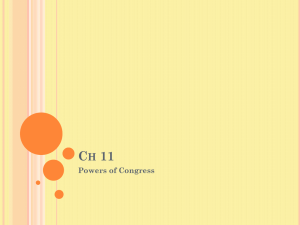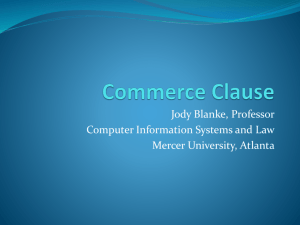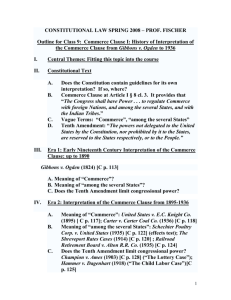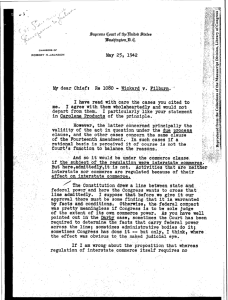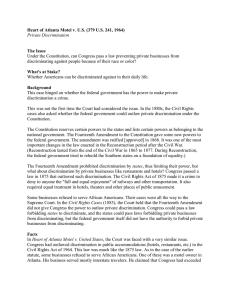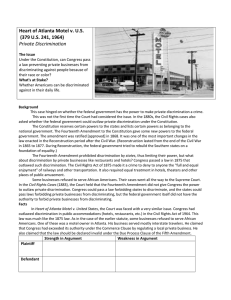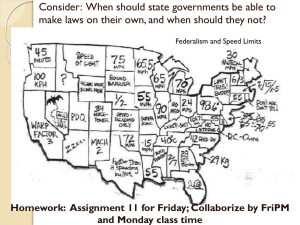Week Eight
advertisement
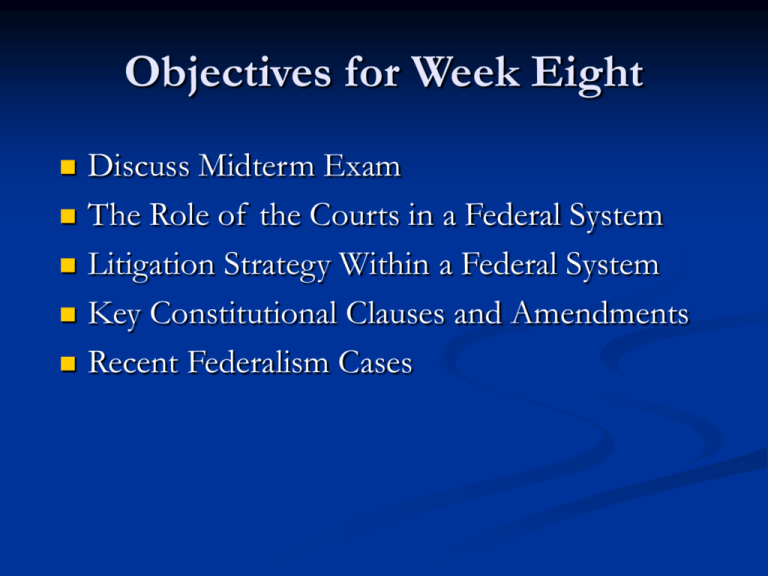
Objectives for Week Eight Discuss Midterm Exam The Role of the Courts in a Federal System Litigation Strategy Within a Federal System Key Constitutional Clauses and Amendments Recent Federalism Cases When Federalism Case Comes Under Domain of Supreme Court Rule of Four Case or controversy; ripe for review; suitable for judiciary to address Cases involving Congressional action or where state court implicates federal law Controversies between states Cases involving treaties and ambassadors Taking Cases to the Court Advantages Provides opportunity for political minorities Rulings can have sweeping effects Disadvantages Backlash Time and resource investment Unpredictable Which actors should bring cases to the Court? How do you define “relief ” in a legal setting? Inadequacy of urban education: If you were to bring a case to court, what kind of relief would you want? Commerce Clause Congress has the power to “regulate commerce with foreign nations and among the several states . . .” Channels of Commerce Instrumentalities of Interstate Commerce Activities having a substantial relation to interstate commerce Necessary and Proper Clause Congress has the authority to “make all laws which shall be necessary and proper for carrying into execution,” its delegated powers 10th Amendment – Reserved Powers “The powers not delegated to the United States by the Constitution, nor prohibited by it to the States, are reserved to the States respectively, or to the people.” Cannot act to impair a state’s ability to perform its “traditional functions” Defining what is “traditional” 11th Amendment – State Immunity from Suits “The Judicial power of the United States shall not be construed to extend to any suit in law or equity, commenced or prosecuted against one of the United States by Citizens of another State, or by Citizens or Subjects of any foreign state.” Commerce Clause Cases Gibbons v. Ogden (1824) NLRB v. Jones & Laughlin (301 U.S. 1) 1937 Wickard v. Filburn (317 U.S. 111) 1942 U.S. v. Darby (312 U.S. 100) 1941 U.S. v. Lopez (514 U.S. 549) 1995 Gun-free School Zone Law: illegal to possess a gun within 1,000 feet of a school Were there limits to Congress’ power to regulate commerce? Did Congress meet the Commerce Clause tests at time of legislative enactment? U.S. v. Morrison – Violence Against Women Act Laws authorizes victims of rape or domestic violence can sue assailants in federal court for violation of civil rights Is this a legitimate use of the Commerce Clause power? th 11 Seminole Tribe v. Florida (517 U.S. 44) 1996 Indian Gaming Regulatory Act: Tribes allowed to sue state government, if state was not negotiating casino matters in good faith. Alden v. Maine (1999) Can state workers go to state court to sue a state for violating federal labor law? Amendment Cases Does restriction on Congress to grant suits in federal courts extend to state courts? College Savings Bank v. Florida Prepaid Postsecondary Educational Expense Board West v. Gibson th 10 National League of Cities v. Usery (426 U.S. 833) 1976 Is Congress responsive to state government? New York v. U.S. (505 U.S. 144) 1992 Can federal minimum wage and overtime laws be extended to state government employees? Garcia v. San Antonio Metro Transit Auth. (469 U.S. 528) 1985 Amendment Cases Can Congress force a state to dispose of low-level radioactive waste generated within that state? Can Congress compel a state to enforce a federal regulatory program? Printz v. New York (521 U.S. 98) 1997 Brady Handgun Violence Protection Act: States required to perform background checks. Violation of 10th Amendment? Legitimate use of Commerce Clause? Implications of Recent Trends Set precedent for lower courts to follow Signal to Congress and state government Encourage other challenges Avenues for recourse are at the state level Potential for greater heterogeneity Creates potential issues for candidate and party platforms Role of the Court Blackmun: “States’ sovereign interests [are] more properly protected by procedural safeguards inherent in the structure of the federal system than by judicially created limitations on federal power.” Scalia: The Supreme Court has a duty to maintain a “healthy balance of power between the states and the federal government.” When Does a Court Decision Have A Lasting Impact? Apply a rule or precedent consistently and frequently Define or assign responsibility and accountability Transform procedures Shape Institutions Defining “suspect” or vulnerable groups in society California’s Position on Residency Requirements Congress intended to prevent welfare magnets Lower-benefit status is not a permanent classification Impact on right to travel is remote Residency requirements are a compelling state interest Migrants are no worse off – not a significant penalty Saenz v. Roe What did the Supreme Court decide? What is the threshold for “taking” from a state? Can you think other situations when states can block or inhibit entry? Treat in-migrants or visitors differently? Readings for Next Time: Readings on Mall Expansion & Empire Zones Chapter Two, Politics in the American States, Gray et al. (pp. 52-60) "Representing Urban Interests," Scott Allard, Nancy Burns, Gerald Gamm, Studies in American Political Development, Fall 1998 "Emerging Trends in State-Local Relationships," Beverly A. Cigler


